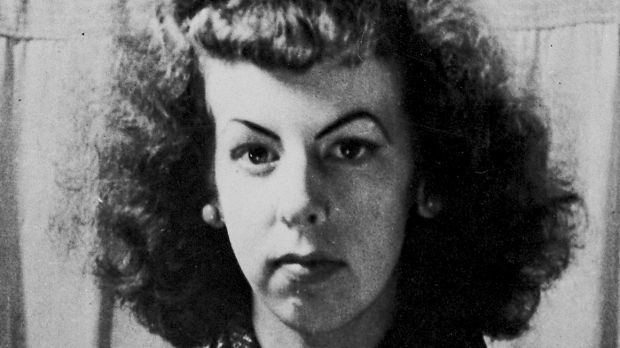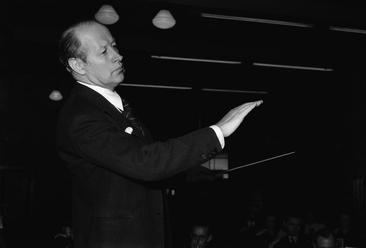Name Eugene Goossens Role Conductor | Parents Eugene Goossens | |
 | ||
Died June 13, 1962, Hillingdon, Uxbridge, United Kingdom Siblings Leon Goossens, Sidonie Goossens, Marie Goossens, Adolphe Goossens Nieces Benedicta Goossens, Corinne Goossens, Jennie Goossens Compositions Suite - op 6: II Serenade, Suite - op 6: II Serenade, Five Impressions of a Holiday - op 7: No 1 In the Hills, Five Impressions of a Holiday - op 7: No 1 In the Hills, Three Pictures - op 55: III From a Balcony in Montparnasse, Three Pictures - op 55: III From a Balcony in Montparnasse, Five Impressions of a Holiday - op 7: No 2 By the Rivers, Five Impressions of a Holiday - op 7: No 2 By the Rivers, Five Impressions of a Holiday - op 7: No 4 The Village Church, Five Impressions of a Holiday - op 7: No 4 The Village Church, Three Pictures - op 55: II From Bredon in the Cotswolds, Three Pictures - op 55: II From Bredon in the Cotswolds, Five Impressions of a Holiday - op 7: No 3 The Water Wheel, Five Impressions of a Holiday - op 7: No 3 The Water Wheel, Four Sketches - op 5 - Book II: III Romance, Four Sketches - op 5 - Book II: III Romance, Four Sketches - op 5 - Book II: IV Huske, Four Sketches - op 5 - Book II: IV Huske, Pastorale et Arlequinade - op 41: I Pastorale, Pastorale et Arlequinade - op 41: I Pastorale, Three Pictures - op 55: I From the Belfry of Bruges (for my friend - Ary van Leeuwen), Three Pictures - op 55: I From the Belfry of Bruges (for my friend - Ary van Leeuwen), Pastorale et Arlequinade - op 41: II Arlequinade, Pastorale et Arlequinade - op 41: II Arlequinade, Four Sketches - op 5 - Book I: II Serenade, Four Sketches - op 5 - Book I: II Serenade, Four Sketches - op 5 - Book I: I Legend, Four Sketches - op 5 - Book I: I Legend, Five Impressions of a Holiday - op 7: No 5 At the Fair, Five Impressions of a Holiday - op 7: No 5 At the Fair, Suite - op 6: III Divertissement, Suite - op 6: III Divertissement, Suite - op 6: I Impromptu, Suite - op 6: I Impromptu, Variations on Cadet Rousselle, Variations on Cadet Rousselle Similar People Leon Goossens, Igor Oistrakh, Sidonie Goossens, David Oistrakh, Jascha Heifetz | ||
Eugene Goossens - By the Tarn, Op. 15, No. 1 (1916) arr. for String Orchestra
Sir Eugene Aynsley Goossens (; 26 May 1893 – 13 June 1962) was an English conductor and composer.
Contents
- Eugene Goossens By the Tarn Op 15 No 1 1916 arr for String Orchestra
- Eugene Aynsley Goossens
- Biography
- Scandal
- Marriages and children
- Death
- Legacy
- Discography
- References

Eugene Aynsley Goossens
Biography

He was born in Camden Town, London, the son of the Belgian conductor and violinist Eugène Goossens (fils, 1867–1958) and Annie Cook, a Carl Rosa Opera Company singer. He was the grandson of the conductor Eugène Goossens (père, 1845–1906; his father and grandfather spelled Eugène with a grave accent; he himself did not). He studied music at the age of ten in Bruges, three years later in Liverpool, and in 1907 in London on a scholarship at the Royal College of Music under composer Charles Villiers Stanford and the violinist Achille Rivarde among others. He won the silver medal of the Worshipful Company of Musicians and was made associate of the Royal College of Music.

He was a violinist in Thomas Beecham's Queen's Hall Orchestra from 1912 to 1915 and performed in the Philharmonic Quartet before coming to attention as Beecham's assistant conductor with a performance of Stanford's opera The Critic (1916). In 1921 he decided to make conducting his career and founded his own orchestra; with this ensemble he made a number of gramophone records for Edison-Bell's Velvet Face label. He gave the British concert premiere of Igor Stravinsky's The Rite of Spring on 7 June 1921 at the Queen's Hall with the composer present.
For nearly a quarter of a century, he accepted positions at U.S. orchestras. At the invitation of George Eastman he was conductor of the Rochester Philharmonic Orchestra from 1923 to 1931. This post also involved teaching at the Eastman School of Music. During the late 1920s he often conducted for Vladimir Rosing's American Opera Company, an organization which grew out of the Eastman School. From 1931 to 1946 he succeeded Fritz Reiner as the conductor of the Cincinnati Symphony Orchestra. In a tribute to Goossens on his departure for Australia, nine American composers collaborated on Variations on a Theme by Eugene Goossens, for orchestra. The composers were Ernest Bloch, Aaron Copland, Paul Creston, Anis Fuleihan, Roy Harris, Walter Piston, Bernard Rogers, Roger Sessions and Deems Taylor, with Goossens himself writing the finale.
Goossens spent nine years in Australia, from 1947 to 1956. He conducted the Sydney Symphony Orchestra and other groups, and was the director of the NSW State Conservatorium of Music. He held these positions concurrently until March 1956, when he was forced to resign after a major public scandal, only a year after being knighted.
Scandal
In the early 1950s, Goossens met Rosaleen Norton, the so-called "Witch of Kings Cross". Norton was known as an artist of the grotesque and for her interest in the occult and erotica, which Goossens secretly shared. They conducted an intense affair, exchanging a number of passionate letters; although Goossens asked Norton to destroy all of them, she kept a bundle hidden behind a sofa.
In early 1956, Goossens visited Europe, unaware that Sydney police were already in possession of his letters to Norton and photographs of her occult activities, which had been stolen from her flat by Sydney Sun reporter Joe Morris, who had infiltrated her supposed "coven". When Goossens returned to Australia on 9 March 1956, he was detained at Sydney Airport, following a tip-off by informants in London; his bags were searched by Customs officials, who found a large amount of what was then considered pornographic material, which included photographs, prints, books, a spool of film, some rubber masks, and sticks of incense.
Although he was not immediately arrested or charged, Goossens naively agreed to attend a police interview a few days later, where he was confronted with photographs of Norton's "ceremonies" and his letters. Faced with the evidence of his affair with Norton – which left him open to the serious charge of "scandalous conduct" – Goossens was forced to plead guilty to the pornography charges. He paid a fine of ₤100; more significantly, the scandal ruined his reputation and forced him to resign from his positions. He returned to England in disgrace.
The scandal was the basis of a novel, Pagan (1990), by Inez Baranay; it also inspired a play, The Devil is a Woman, by Louis Nowra and an opera, Eugene & Roie, by Drew Crawford. The scandal is documented in the film The Fall of the House, directed by Geoff Burton.
Marriages and children
He was married three times: to Dorothy Millar from 1919 to 1928 (with whom he had three daughters), to Janet Lewis from 1930 to 1944 (two daughters), and to Marjorie Foulkrod from 1946 to 1962 (childless). At the end of his life he and his wife lived apart, and he was instead joined by a young pianist from Adelaide, Pamela Main.
Death
His former student Richard Bonynge visited him near the end of his life, and found him "absolutely destroyed". Nevertheless, he was engaged for work with the BBC, and Everest Records asked Goossens to make some stereo recordings. For Everest he completed a powerful recording of Respighi's Feste Romane just before his death and it was released as the sole selection on the LP. His other Everest recordings included Rimsky-Korsakov's Scheherazade, Rachmaninoff's Symphonic Dances and Tchaikovsky's Manfred Symphony.
He died of rheumatic fever and a haemorrhaging gastric ulcer on 13 June 1962 at Hillingdon Hospital in Middlesex. He was buried in St Pancras and Islington Cemetery. He left his estate including copyrights and royalties "to my faithful companion and assistant Miss Pamela Main".
Legacy
Among his works as a composer are two symphonies (1940, 1945), two string quartets, two violin sonatas and a concertino for octet among other chamber music. He wrote two operas. Don Juan de Manara was broadcast by the BBC on 11 April 1959 with Monica Sinclair, Marie Collier, Helen Watts, Marion Lowe, Bruce Boyce, Robert Thomas and Andrei McPherson. The performance was conducted by Goossens himself. He wrote an oratorio, The Apocalypse, after the Revelation of St. John, and a concerto for oboe (1927), written for his brother, Léon Goossens. The concertino, from 1928, also exists in a later arrangement for string orchestra which is sometimes played.
In 1942 Goossens wrote to several composers, including Aaron Copland, to request patriotic fanfares as "stirring and significant contributions to the war effort..." Copland responded to the request with his famous Fanfare for the Common Man. Eighteen fanfares were written by the different composers and performed during the 1942/43 season of the Cincinnati Symphony Orchestra.
In 1941 he made the first American recording of the Symphony No. 2 by Tchaikovsky, with the Cincinnati Symphony Orchestra. Goossens' recording ignored the cuts that were popular with conductors at that time. That same year, also with the Cincinnati Symphony, he recorded Vaughan Williams' A London Symphony, in its 1920 edition, and also the original version of Walton's Violin Concerto, with Jascha Heifetz as soloist.
For Kapp Records, he recorded a bilingual version of Peter and the Wolf in 1959, featuring the actor José Ferrer narrating the story in both English and Spanish. The music was played by the Vienna State Opera Orchestra. The performance was later released on CD by MCA Records.
Goossens is credited for much of the lobbying to the NSW Government to build a music performance venue, a process that led to the construction of the Sydney Opera House. Having agreed to go ahead with the project, the New South Wales Premier Joseph Cahill had wanted it to be on or near Wynyard Railway Station in the north-west of the CBD, but Goossens insisted that it be built at Bennelong Point overlooking Sydney Harbour. The site of Bennelong Point was confirmed in 1957, after he had left Australia.
He is commemorated in the Eugene Goossens Hall, a small concert and recording facility that is part of the broadcasting complex of the Australian Broadcasting Corporation in Harris Street, Ultimo, in Sydney.
Discography
A far from complete listing:
